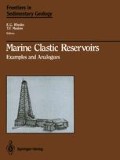Abstract
The discovery of the Canto do Amaro oil field in November 1985 is a milestone in the exploratory history of the Potiguar Basin, which has turned out to be the most productive onshore oil field of Brazil and has opened new prospects in an area previously considered to be of minor importance. The Canto do Amaro oil field is located in the onshore part of the Potiguar Basin, Rio Grande do Norte State, in the extreme northeast corner of Brazil (Fig. 9.1). This field has nineteen producing zones, all of them in sandstones of the Upper Cretaceous Açu Fm. The Açu Fm in the Canto do Amaro area is about 650 m thick, and shows, from the base to the top, a transition from coarse sandstones deposited by braided rivers, through medium sandstones deposited by meandering rivers, to fine sandstones deposited in a marginal marine system. The fine sandstones grade upward into an argillaceous zone and then into the shallow-marine limestones of the Jandaira Fm, making up a transgressive megasequence (Fig. 9.2).
Access this chapter
Tax calculation will be finalised at checkout
Purchases are for personal use only
Preview
Unable to display preview. Download preview PDF.
References
Barwis, J.H., and Makurath, J.H., 1978, Recognition of ancient tidal inlet sequences: An example from the Upper Silurian Keyser Limestone in Virginia: Sedimentology, v. 25, p. 61–82.
Curtis, C.D., 1983, Link between aluminum mobility and destruction of secondary porosity: Am. Assoc. Petrol. Geol. Bull., v. 67, p. 380–393.
Dickinson, W.R., 1970, Interpreting detrital modes of graywacke and arkose: J. Sediment. Petrol., v. 40, p. 695–707.
Donselaar, M.E., and Nio, S.D., 1982, An Eocene tidal inlet/washover type barrier island complex in the South Pyrenean marginal basin, Spain; Geol. Mijnb., v. 61, p. 343–353.
Duc, A.W., and Tye, R.S., 1987, Evolution and stratigraphy of a regressive barrier/backbarrier complex: Kiawah Island, South Carolina: Sedimentology, v. 34, p. 237–251.
Galloway, W.E., and Hobday, D.K., 1983, Terrigenous clastic depositional environments: New York, Springer-Verlag, 423 p.
Hayes, M.O., and Kana, T.W., 1976, Terrigenous clastic depositional environments—some modern examples: Columbia University of South Carolina, Coastal Research Division, Tech. Rept. II-CRD, p. I-131-II-184.
Hobday, D.K., and Horne, J.C., 1977, Tidally influenced barrier island and estuarine sedimentation in the Upper Carboniferous of southern West Virginia: Sedimentary Geology, v. 18, p. 97–122.
Home, J.C., and Ferm, J.C., 1976, Carboniferous depositional environments in the Pochahontas Basin, eastern Kentucky and southern West Virginia: Columbia University of South Carolina, Field Course Guidebook.
Israel, A.M., Ethridge, F.G., and Estes, E.L., 1987, A sedimentologic description of a microtidal, flood-tidal delta, San Luis Pass, Texas: J. Sediment. Petrol., v. 57, p. 288–300.
Ixer, R.A., Turner, P., and Waugh, B., 1979, Authigenic iron and titanium oxides in Triassic red beds: St. Bees Sandstone, Cumbria, Northern England: Geol. J., v. 14, p. 179–192.
Kumar, N., and Sanders, J.E., 1974, Inlet sequence: A vertical succession of sedimentary structures and textures created by the lateral migration of tidal inlets; Sedimentology, v. 21, p. 491–532.
McBride, E.F., 1963, A classification of common sandstones: J. Sediment. Petrol., v. 33, p. 664–669.
McCubbin, D.G., 1982, Barrier-island and strand-plain facies, in Scholle, P.A., and Spearing, D., eds., Sandstone depositional environments: Am. Assoc. Petrol. Geol. Memoir 31, p. 247–279.
Moslow, T.F., 1984, Depositional models of shelf and shoreline sandstones: Am. Assoc. Petrol. Geol. Cont. Ed. Course Notes, Series 27, 102 p.
Moslow, T.F., and Tye, R.S., 1985, Recognition and characterization of Holocene tidal inlet sequences: Marine Geol., v. 63, p. 129–151.
Rahmani, R.A., 1988, Estuarine tidal channel and nearshore sedimentation of a Late Cretaceous epicontinental sea, Drumheller, Alberta, Canada, inde Boer, P.L., van Gelder, A., and Nio, S.D., eds., Tide-influenced sedimentary environments and facies: Boston D. Reidel, p. 433–471.
Reineck, H.-E., Sing, L.B., 1980, Depositional sedimentary environments; 2nd ed.: Berlin, Springer-Verlag, 549 p.
Schmidt, V., and McDonald, D.A., 1979, Texture and recognition of secondary porosity in sandstones, in Scholle, P.A., and Schluger, P.R., eds., Aspects of diagenesis: Soc. Econ. Paleont. Mineral. Spec. Publ. 26, p. 209–225.
Turner, P., 1980, Continental red beds: Amsterdam, Elsevier, 562 p.
Visser, M.J., 1980, Neap-spring cycles reflected in Holocene subtidal large-scale bedform deposits A preliminary note: Geology, v. 8, p. 543–546.
Editor information
Editors and Affiliations
Rights and permissions
Copyright information
© 1993 Springer-Verlag New York, Inc.
About this chapter
Cite this chapter
Bagnoli, E. (1993). The Mossoró Sandstone, Canto do Amaro Oil Field, Late Cretaceous of the Potiguar Basin, Brazil: An Example of a Tidal Inlet-Channel Reservoir. In: Rhodes, E.G., Moslow, T.F. (eds) Marine Clastic Reservoirs. Frontiers in Sedimentary Geology. Springer, New York, NY. https://doi.org/10.1007/978-1-4757-0160-9_9
Download citation
DOI: https://doi.org/10.1007/978-1-4757-0160-9_9
Publisher Name: Springer, New York, NY
Print ISBN: 978-1-4757-0162-3
Online ISBN: 978-1-4757-0160-9
eBook Packages: Springer Book Archive

